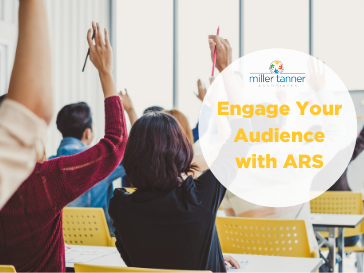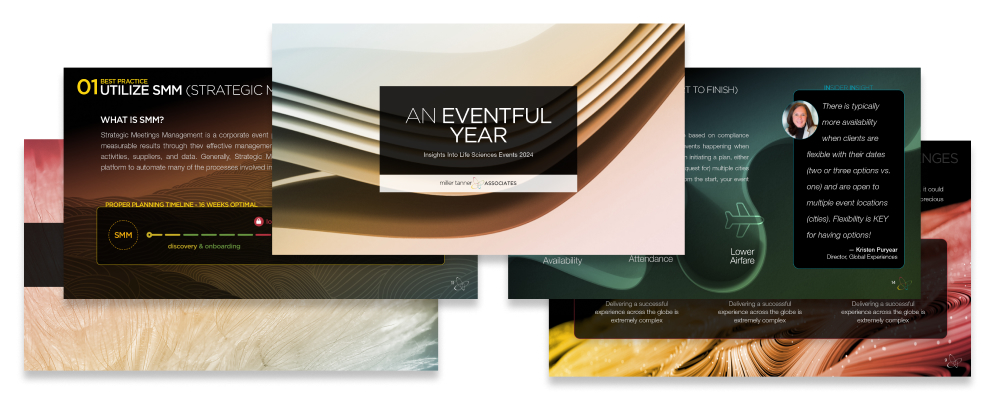Let’s face it, we live in a distracting world. Attention spans are short (shorter than a goldfish) and people are busy. As a presenter or meeting sponsor, it’s tough to compete with the constant barrage of distractions diverting our audience’s attention.
The answer to ensuring that your audience is alert and engaged isn’t more coffee, but rather more dialogue – less monologue. That’s right, more interaction with your audience.
But how can you increase interaction during your presentation without derailing it?
As meeting planners, we have some ideas. One of the most effective ways that we’ve found to assess and engage your audience is by using an Audience Response System (ARS) to enhance your meeting. By using these small yet powerful devices, your presentation becomes three dimensional – more interactive, more engaging, and more educational.
How ARS can keep your audience engaged and informed:
1). Real-Time Live Discussion
With ARS, you can dialogue and engage in real-time discussions with your audience. Using the handheld ARS smart device, your audience can answer live multiple-choice questions and text questions or comments, which can be displayed on a monitor in front of you and your audience all in real-time. This adds tremendous value as it allows you to instantly gauge audience comprehension and retention of the valuable data being presented, capture thoughts, respond to questions, and steer the discussion in a way that is most impactful to your audience and your messaging.
Additionally, the ability for individuals to process information in real-time is essential. If an attendee has a question, it can be asked and answered immediately to reinforce learning objectives.
2). Instant Feedback
One of the benefits of using an ARS tool is the ability to receive instant feedback from your audience. You can gauge your audience’s understanding throughout your presentation which allows you to tailor your message as needed. Instant feedback generates further dialogue and discussion as you display instant results live to your audience. Assessing how the data is being received and comprehended by your audience, in real-time, allows you to shift the messaging as needed, to address areas of learning that may need reinforcement.
3). Traditional Lecture Style Versus Interactive Learning
With ARS, you can transform your meeting from a traditional lecture style to an interactive learning environment. You can ask your audience questions in a wide variety of formats, such as multiple choice, rating, text response, polling, voting and even fun game challenges, which are great for team building. With these methods of engagement, your audience will be more inclined to participate and interact with the presentation.
4). Track Attendance and Responses
ARS can be used for tracking attendance and responses for auditing, training, and certification as well. ARS allows you to create a record of all questions and attendee responses, giving you an instant snapshot of the training, a record of attendee comprehension, and a trackable report of the entire audience’s understanding of the data presented.
5). Adapts the Direction of Your Meeting in Response to Your Attendees’ Views
With the option of live polling, presenters can gain insights and gauge the level of understanding among their audience as well as any learning gaps. This feedback is vital to the delivery of your message, as presenters have the opportunity to adapt the presentation objectives to cater to the audience needs.
6). Assess Your Audience’s Knowledge Base
With ARS, you can measure and determine, even before your presentation begins, the knowledge base of your audience by conducting a quick assessment. Results are compiled instantaneously. This further allows you to tailor your presentation to the learning needs of your audience.
Key Questions to Ask
Now that we’ve discussed the benefits, here are some tips to consider when developing your ARS questions:
- What are the three to five main points of this presentation you want attendees to understand?
- Based on past experience with previous presentations are there any topics that could be misunderstood?
- Mix easier questions in with more difficult ones. If they are all difficult, the participants may tend to lose confidence if they are not getting any correct.
- Craft questions that will help you identify training needs.
- Think back to prior feedback. Are there any areas you wish you had spent more time clarifying?
- Craft some questions that may not be clear cut, and have an answer of “possibly”. That will allow you to employ a discussion technique to better clarify the issue.
- Use “scenario” questions.
MTA offers several device options, system formats and price points to ensure that no matter what the vision and ultimate goal of the interactive audience participation portion of the event may be, you will receive the best data and value possible. Each system offers a flexible toolset that will engage, educate and entertain your audience. For a demonstration of our ARS tool, contact Miller Tanner Associates today.
- Meet MTA: Steven Garberg, Software Engineer, MTA Technology Services - September 15, 2020
- Case Study: How a Hotel Contract Cancellation Clause Resulted in Zero Penalty During Pandemic - August 20, 2020
- Virtual Events: Frequently Asked Questions - August 11, 2020



